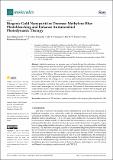Files in this item
Biogenic gold nanoparticles decrease methylene blue photobleaching and enhance antimicrobial photodynamic therapy
Item metadata
| dc.contributor.author | Maliszewska, Irena | |
| dc.contributor.author | Wanarska, Ewelina | |
| dc.contributor.author | Thompson, Alex C. | |
| dc.contributor.author | Samuel, Ifor D. W. | |
| dc.contributor.author | Matczyszyn, Katarzyna | |
| dc.date.accessioned | 2021-02-02T17:30:02Z | |
| dc.date.available | 2021-02-02T17:30:02Z | |
| dc.date.issued | 2021-01-25 | |
| dc.identifier.citation | Maliszewska , I , Wanarska , E , Thompson , A C , Samuel , I D W & Matczyszyn , K 2021 , ' Biogenic gold nanoparticles decrease methylene blue photobleaching and enhance antimicrobial photodynamic therapy ' , Molecules , vol. 26 , no. 3 , 623 . https://doi.org/10.3390/molecules26030623 | en |
| dc.identifier.issn | 1420-3049 | |
| dc.identifier.other | PURE: 272663078 | |
| dc.identifier.other | PURE UUID: 6f213fe6-0d43-4610-aa1b-e244097404f9 | |
| dc.identifier.other | Bibtex: molecules26030623 | |
| dc.identifier.other | Scopus: 85100563418 | |
| dc.identifier.other | WOS: 000615438000001 | |
| dc.identifier.uri | https://hdl.handle.net/10023/21356 | |
| dc.description | This work was partially financed by a statutory activity subsidy from the Polish Ministry of Science and Higher Education (PMSHE) for the Faculty of Chemistry of Wrocław University of Science and Technology. We are grateful to the Photobiology Trust and the Engineering and Physical Sciences Research Council of the U.K. for financial support. Funding from Polythea MSCA-ITN-EJD 764837 project is acknowledged. | en |
| dc.description.abstract | Antibiotic resistance is a growing concern that is driving the exploration of alternative ways of killing bacteria. Here we show that gold nanoparticles synthesized by the mycelium of Mucor plumbeus are an effective medium for antimicrobial photodynamic therapy (PDT). These particles are spherical in shape, uniformly distributed without any significant agglomeration, and show a single plasmon band at 522–523 nm. The nanoparticle sizes range from 13 to 25 nm, and possess an average size of 17 ± 4 nm. In PDT, light (from a source consisting of nine LEDs with a peak wavelength of 640 nm and FWMH 20 nm arranged in a 3 × 3 array), a photosensitiser (methylene blue), and oxygen are used to kill undesired cells. We show that the biogenic nanoparticles enhance the effectiveness of the photosensitiser, methylene blue, and so can be used to kill both Gram-positive (Staphylococcus aureus) and Gram-negative (Escherichia coli) bacteria. The enhanced effectiveness means that we could kill these bacteria with a simple, small LED-based light source. We show that the biogenic gold nanoparticles prevent fast photobleaching, thereby enhancing the photoactivity of the methylene blue (MB) molecules and their bactericidal effect. | |
| dc.format.extent | 16 | |
| dc.language.iso | eng | |
| dc.relation.ispartof | Molecules | en |
| dc.rights | Copyright © 2021 by the authors. Licensee MDPI, Basel, Switzerland. This article is an open access article distributed under the terms and conditions of the Creative Commons Attribution (CC BY) license (http://creativecommons.org/licenses/by/4.0/). | en |
| dc.subject | RC0254 Neoplasms. Tumors. Oncology (including Cancer) | en |
| dc.subject | RM Therapeutics. Pharmacology | en |
| dc.subject | DAS | en |
| dc.subject | SDG 3 - Good Health and Well-being | en |
| dc.subject.lcc | RC0254 | en |
| dc.subject.lcc | RM | en |
| dc.title | Biogenic gold nanoparticles decrease methylene blue photobleaching and enhance antimicrobial photodynamic therapy | en |
| dc.type | Journal article | en |
| dc.description.version | Publisher PDF | en |
| dc.contributor.institution | University of St Andrews. School of Physics and Astronomy | en |
| dc.contributor.institution | University of St Andrews. Centre for Biophotonics | en |
| dc.contributor.institution | University of St Andrews. Condensed Matter Physics | en |
| dc.identifier.doi | https://doi.org/10.3390/molecules26030623 | |
| dc.description.status | Peer reviewed | en |
This item appears in the following Collection(s)
Items in the St Andrews Research Repository are protected by copyright, with all rights reserved, unless otherwise indicated.

